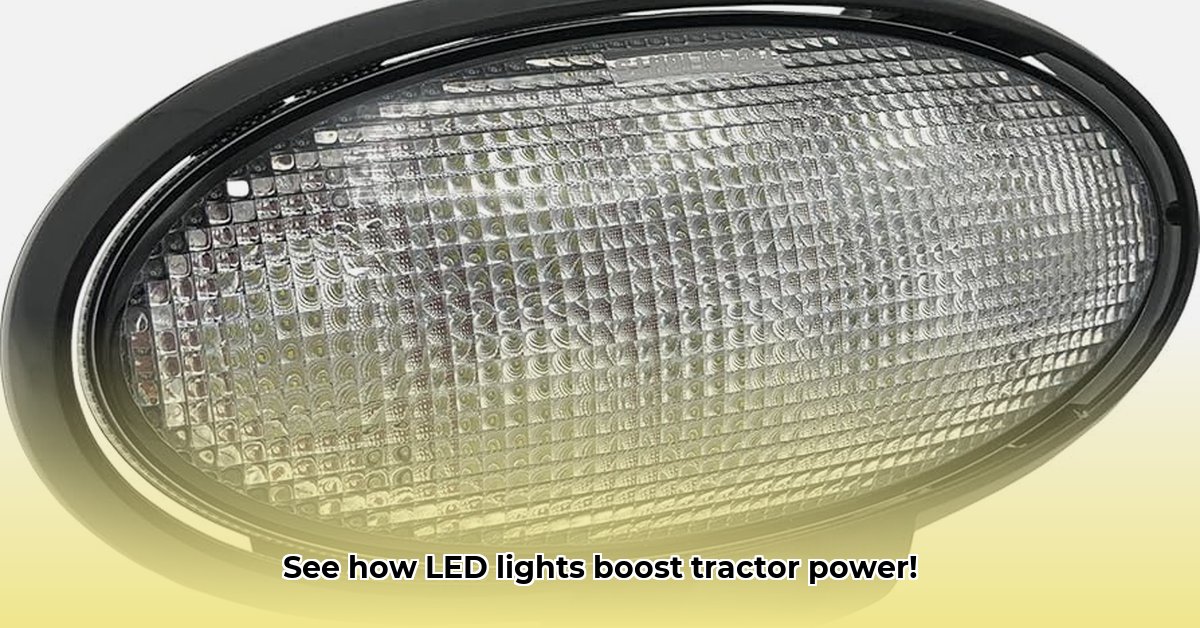
12 Volt LED Lights for Tractors: A Comprehensive Guide
Modernizing your tractor's lighting system with 12V LED lights offers significant advantages beyond brighter illumination. It's a strategic move towards more sustainable and efficient agricultural practices, impacting your bottom line and environmental responsibility. This guide provides a practical, step-by-step approach to upgrading your tractor's lighting, covering selection, installation, and maintenance. For even more in-depth information, check out this detailed guide.
Why Swap to LEDs? A Significant Farm Upgrade
Traditional halogen and incandescent tractor lights are inefficient, short-lived, and generate considerable heat. 12V LED lights provide a compelling alternative. But how much better are they, really? Let's look at a side-by-side comparison:
| Feature | Incandescent/Halogen | LED |
|---|---|---|
| Energy Consumption | High | Very Low |
| Lifespan | Short | Extremely Long |
| Light Output | Dim | Bright, Focused |
| Heat Production | High | Low |
| Initial Cost | Lower | Higher (but pays off long-term) |
The superior energy efficiency of LEDs directly translates to lower fuel consumption, reduced operating costs, and decreased greenhouse gas emissions – a win for both your wallet and the environment. Their extended lifespan minimizes replacements, saving time and labor. The reduced heat output enhances safety and prevents damage to surrounding components. Isn't it time you considered the long-term benefits?
Types of 12 Volt LED Tractor Lights
The market offers a variety of 12V LED lights designed for specific tractor applications. Understanding these differences is key to making an informed choice:
- Work Lights: High-intensity lights designed to illuminate large areas, ideal for night harvesting, fieldwork, and repairs.
- Headlights: Essential for safe nighttime operation, improving visibility and navigation.
- Interior Lights: Enhance visibility and safety during maintenance or operation within the tractor cab. These small lights can even improve your long-term work experience.
- Backup Lights: Crucial safety feature for reversing, preventing accidents by maximizing visibility behind the tractor.
The optimal choice depends on your tractor's size, workload, and operational needs. Larger tractors with extensive nighttime use will benefit from more powerful and numerous lights. Consider your specific requirements carefully to maximize the benefits.
Choosing the Right 12 Volt LED Lights: A Selection Guide
Selecting the right lights involves considering several key specifications:
- Lumens: A measure of light brightness. Higher lumens mean brighter illumination.
- Wattage: Indicates power consumption. LEDs offer superior brightness with significantly lower wattage.
- Color Temperature (Kelvin): Affects the light's color. Higher Kelvin values (e.g., 5000K) produce cooler, whiter light, often preferred for nighttime visibility.
- Beam Pattern: Flood beams illuminate a wide area, while spot beams provide a concentrated, long-range beam. Consider your specific lighting needs.
- Durability: Opt for lights constructed to withstand vibrations, moisture, dust, and other harsh agricultural conditions. This is crucial for long-term performance.
Carefully evaluate these factors to ensure your chosen lights meet your specific needs and operating environment. Investing in durable, high-quality lights will yield long-term savings and enhanced safety.
Installing Your New 12 Volt LED Lights: A Step-by-Step Guide
Safety Precautions: Always disconnect the tractor's battery before commencing any electrical work to prevent shocks and damage.
- Planning and Placement: Identify suitable mounting locations on your tractor, considering optimal illumination and structural integrity.
- Wiring: Run appropriate gauge wiring from your tractor's power source to each light, ensuring proper grounding. Consult your tractor's manual for wiring diagrams and specifications. If unsure, seek professional assistance.
- Mounting: Securely attach the lights using the provided hardware. Ensure a firm mount to withstand vibrations.
- Testing: Reconnect the battery and test all lights to confirm proper functionality.
Remember, if you're uncomfortable with any aspect of the installation, consult a qualified electrician or mechanic. Professional installation ensures safety and optimal performance.
Maintenance and Troubleshooting
Regular maintenance prolongs the lifespan of your LED lights and ensures optimal performance:
- Regular Inspection: Periodically check for loose wiring, cracks, or damage. Address these issues promptly to prevent more significant problems.
- Cleaning: Regularly clean the lenses to maintain brightness and prevent dirt buildup from reducing light output.
Troubleshooting common issues, such as flickering lights or complete failure, often involves checking the wiring and connections before replacing the lights themselves.
Conclusion: Illuminate Your Farm's Future
Upgrading to 12V LED tractor lights offers substantial benefits, including enhanced safety, improved efficiency, reduced operating costs, and a smaller environmental footprint. This relatively straightforward upgrade is a worthwhile investment in your farm's productivity and sustainability. Embrace the future of brighter, more efficient farming.